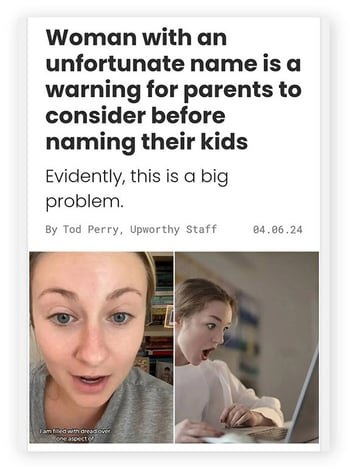What is clickbait?
Clickbait is content that drives traffic to a website or blog using sensationalized or misleading headlines. These headlines aim to pique your interest or emotions, making you want to click the link, image, or video. The goal of clickbait ads and headlines is to grab your attention in any way possible to entice you to click through to a website and generate ad revenue.
Each time you click on a monetized website or blog hosting link, it generates revenue through advertising — that’s why outrageous headlines that grab your attention are a critical ingredient in the clickbait financial model. Clickbait content is almost always questionable in quality and accuracy. Even worse, clickbait could lead to fake websites that promote phishing scams or spread malware.
What are the signs of clickbait?
Some of the main signs of clickbait marketing and other clickbaity sites are outrageous claims, fear mongering, or potentially-offensive language. It's possible to package any piece of content as clickbait, but there are some obvious signs to look for to tell if a piece of content is truly clickbait.
Clickbait links often contain the following signs:
-
Vague headlines
-
Outrageous claims
-
Promises that sound too good to be true
-
Scary or sensational headlines
-
Headlines in poor taste
-
Eye-catching, ridiculous imagery
-
Articles full of pictures, memes, and ads with little helpful content
Classic clickbait examples
Clickbait can come in many different shapes and sizes. Here are a few classic clickbait examples:
"You won't believe…."
Headlines that use this type of sensational language help create a sense of anticipation to get users to click. Clickbait examples in this style are often followed by claims like the ones below:
In the example below, the headline implies the “you won’t believe” sentiment, while using an eye-catching thumbnail of a miniature phone.
.jpg?width=664&height=541&name=img-01-2%20(1).jpg) Source: Anazala Family channel on YouTube
Source: Anazala Family channel on YouTube
"Things you need to know…"
Another classic example of clickbait headlines are lists discussing top tips in music, sports, sales, money-making schemes, foods for living longer, lifestyle tips, and more. These headlines can be difficult to resist as they tap into your curiosity and compel you to click the link so you don’t miss out on “important information.”
In the example headline below, users are supposed to be compelled to read the article to find out the subject’s name. It also wants future parents to click and read it to ensure they avoid problematic names for their children.
 Source: Upworthy via TheSam_SHow TikTok channel
Source: Upworthy via TheSam_SHow TikTok channel
"This is what happens if you…"
This type of headline takes more of a fear-mongering approach by persuading users to click the link based on a sense of FOMO (fear of missing out). These headlines work well because they appeal to that need-to-know emotion in all of us.
In the clickbait example below, the headline attempts to scare parents into clicking the link to find out what might happen if they continue saying certain things to their kids.
 Source: Buzzfeed Parents portal
Source: Buzzfeed Parents portal
Who created clickbait?
In 2006, Jay Geiger coined the term “clickbait” in one of his blog posts. It’s a portmanteau of "click," for the clicks of a computer mouse, and "bait" for the food used to entice fish or other animals. This compound word symbolizes how some clickbait content treats internet users much like prey when pushing them to click on outlandish content. In 2016, the Oxford English Dictionary officially added "clickbait" as a new word.
The history of clickbait
Although clickbait is relatively new, this strategy has existed for much longer. In the 1800s, newspaper outlets began dabbling with a strategy called Yellow Journalism. The goal of this type of journalism, according to a Fronteiras study on clickbait, was to grab public attention and boost newspaper sales by using sensationalized headlines dependent on sentimentality, exaggeration, and eye-catching topics and illustrations.
An example of Yellow Journalism was an event labeled The Great Moon Hoax of 1835. A story from the New York Sun stated that a British astronomer named Sir John Herschel discovered signs of life on the moon. This sensational story remained popular for several days, but of course the story and the published images were entirely fake. (Some attribute this moment to the birth of fake news.)
 An example of the “man-bats” claimed to have been seen on the moon by a telescope in 1835. Source: Wikimedia Commons
An example of the “man-bats” claimed to have been seen on the moon by a telescope in 1835. Source: Wikimedia Commons
Ultimately, the New York Sun grew in popularity despite this false news story, and its newspapers increased in circulation in the following years — the ultimate goal of Yellow Journalism. This early example of a clickbait-style news strategy shows how such a successful, albeit misleading, campaign can be a lucrative option for firms focused on profits by any means necessary.
Who uses clickbait and why?
Individuals posting on social media or media companies trying to grab audiences’ attention often use clickbait as a tool to drive engagement and boost revenue. Clickbait is often an enticing option for marketers and companies that prioritize boosting their brand's reach or increasing engagement on social media in hopes of driving higher profits.
Organizations or individuals that use clickbait to drive website traffic aim to exploit the curiosity gap — a person's inherent need to know the answer to a vague question or statement. Generally, these practices are focused on making money with clickbait instead of on other more honest ventures (such as accuracy or an informed audience).
Is clickbait a concern?
While clickbait itself is not always a concern, it’s certainly controversial. At best, clickbait is silly and harmless, with the overall goal to increase clicks. But, clickbait can be responsible for spreading dangerous misinformation. Clickbait scams are also very concerning.
Search engines like Google use algorithms (such as PageRank and TrustRank algorithms) to help filter out fake news articles and spam that contain sensationalized and misleading content. But these algorithms can’t catch everything, and they can be manipulated to a certain extent.
At its worst, clickbait can take users to sites containing viruses or malware (like Trojan Horses) or use seemingly innocuous quizzes that collect sensitive personal data that can be sold to data brokers.
Protect your devices with AVG Secure Browser
If you're looking for a more secure browsing experience with fewer disruptions, install AVG Secure Browser, designed by security experts to make your online experiences safer. AVG Secure Browser helps block malicious websites and downloads, forces HTTPS encryption for each website you visit, and limits browser fingerprinting. Get it free today to start safeguarding your online sessions against malicious sites you might land on as a result of clickbait tactics.

.jpg?width=664&height=541&name=img-01-2%20(1).jpg) Source:
Source:  Source:
Source:  Source:
Source:  An example of the “man-bats” claimed to have been seen on the moon by a telescope in 1835. Source:
An example of the “man-bats” claimed to have been seen on the moon by a telescope in 1835. Source: 













